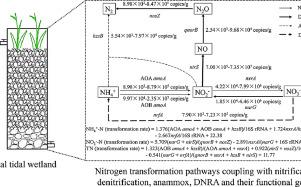Water Research ( IF 11.4 ) Pub Date : 2021-07-20 , DOI: 10.1016/j.watres.2021.117446 Manping Zhang , Zi-Jing Wang , Jung-Chen Huang , Shanshan Sun , Xijun Cui , Weili Zhou , Shengbing He

|
The present study investigated the performance in nitrogen removal and associated nitrogen transformation processes in seven mesocosms fed with saline water (0‰ to 30‰) to simulate tidal flow constructed wetlands (TF CWs). The highly effective and steady removal of NH4+-N (84.74% averagely) was obtained at various salinities, while the rates varied from 6.34% to 89.19% and 22.54% to 87.48% for NO3−-N and total nitrogen (TN), respectively. Overall, nitrogen removal efficiencies were greater at lower salinities. Molecular biological analyses verified the co-occurrence of dissimilatory nitrate reduction to ammonium (DNRA), denitrification, anaerobic ammonium oxidation (anammox) and nitrification in the mesocosms, reportedly contributing to nitrogen removal in TF CWs. The absolute copy numbers of nitrogen functional genes and total bacterial 16S rRNA were 2.54 × 103-7.35 × 107 and 3.21 × 107-7.82 × 109 copies g−1 dg (dry gravel), respectively, with the dominant phyla, i.e., Chloroflexi, Proteobacteria, Actinobacteriota, Cyanobacteria, and Firmicutes, accounting for over 80% of the sequences. The relative abundances of the genera related to nitrification and dissimilatory nitrate reduction processes, i.e., denitrification, anammox and DNRA, varied from 0.16% to 0.89% and from 3.66% to 11.59%, respectively, while quantitative relationships confirmed NH4+-N transformation rate was jointly controlled by amoA, hzsB, nxrA and nrfA, and NO3−-N removal rate by nirS, nosZ, narG, qnorB and nxrA. These findings may shed light on quantitative molecular mechanisms for nitrogen removal in TF CWs for the saline water treatment, providing a sustainable solution to nitrogen pollution problem in the estuary ecosystem.
中文翻译:

人工潮汐湿地盐分驱动脱氮及其定量分子机制
本研究调查了七个用盐水(0‰至30‰)喂养的中层世界中氮去除和相关氮转化过程的性能,以模拟潮汐流人工湿地(TF CW)。NH 4 + -N 去除率在不同盐度下均能高效稳定去除(平均 84.74%),NO 3 -去除率从 6.34% 到 89.19% 和 22.54% 到 87.48% 不等。-N 和总氮 (TN),分别。总体而言,在较低盐度下脱氮效率更高。分子生物学分析证实了异化硝酸盐还原为铵 (DNRA)、反硝化、厌氧铵氧化 (anammox) 和中层世界中的硝化作用的共同发生,据报道,这有助于 TF CW 中的氮去除。氮功能基因和总细菌16S rRNA的绝对拷贝数分别为2.54 × 10 3 -7.35 × 10 7和3.21 × 10 7 -7.82 × 10 9拷贝g -1dg(干砾石)分别具有优势门,即 Chloroflexi、Proteobacteria、Actinobacteriota、Cyanobacteria 和 Firmicutes,占序列的 80% 以上。与硝化和异化硝酸盐还原过程相关的属的相对丰度,即反硝化、厌氧氨氧化和 DNRA,分别从 0.16% 到 0.89% 和从 3.66% 到 11.59%,而数量关系证实了 NH 4 + -N 转化速率由amoA、hzsB、nxrA和nrfA共同控制,NO 3 - -N 去除率由nirS、nosZ、narG、qnorB和nxrA 共同控制. 这些发现可能揭示了用于咸水处理的 TF CW 中氮去除的定量分子机制,为河口生态系统中的氮污染问题提供了可持续的解决方案。











































 京公网安备 11010802027423号
京公网安备 11010802027423号